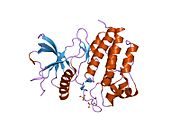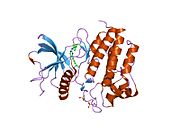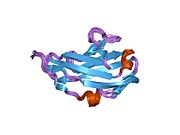Receptor 2 fibroblastnog faktora rasta
| edit |
Receptor 2 fibroblastnog faktora rasta (FGFR2, CD332, klaster diferencijacije 332) protein je koji je kod ljudi kodiran FGFR2 genom lociranom na hromozomu 10.[1][2] FGFR2 is a receptor for fibroblastni faktor rasta.
Protein kodiran ovim genom je član familije receptora fibroblastnih faktora rasta (FGFR) među kojima je aminokiselinska sekvenca visoko konzervirana tokom evolucije.[3] Članovi FGFR familije se međusobno razlikuju po nihovom afinitetu za ligande i tkivnoj distribuciji. Reprezentativni protein pune dužine se sastoji od ekstracelularnog regiona, sastavljenog od tri imunoglobulinu slična domena, jednog hidrofobnog jednoprolaznog membranskog segmenta i citoplazmatičnog tirozinskog kinaznog domena. Ekstracelularna porcija proteina interaguje sa fibroblastnim faktorima rasta, čime se pokreće signalna kaslada koja utiče na mitogenezu i diferencijaciju. Ovaj član familije se vezuje za kisele, bazne i/ili keratinocitne faktore rasta u zavisnosti od izoforme.
Izoforme[uredi | uredi kod]
FGFR2 je prirodno javlja u obliku dve izoforme FGFR2IIIb i FGFR2IIIc, formirane splajsovanjem trećeg imunoglobulinu sličnog domena. FGFR2IIIb se predominantno javlja u tkivu izvedenom iz ektoderma i površinskom sloju endotelnih organa, i.e. koža i unutrašnji organi.[4] FGFR2IIIc se javlja u mesenhimu, što kosti glave i lica i stoga su mutacije ovog gena asocirane sa kraniosinostozom.
Interakcije[uredi | uredi kod]
Receptor 2 fibroblastnog faktora rasta formira interakcije sa FGF1.[5][6][7]
Splajsne izoforme se razlikuju u vezivanju:[8]
- FGFR2IIIb se vezuje za FGF-1, -3, -7, -10, -22
- FGFR2IIIc se vezuje za FGF-1, -2, -4, -6, -8, -9, -17 i -18
Vidi još[uredi | uredi kod]
Reference[uredi | uredi kod]
- ↑ Houssaint E, Blanquet PR, Champion-Arnaud P, Gesnel MC, Torriglia A, Courtois Y, Breathnach R (October 1990). „Related fibroblast growth factor receptor genes exist in the human genome”. Proc. Natl. Acad. Sci. U.S.A. 87 (20): 8180–4. DOI:10.1073/pnas.87.20.8180. PMC 54916. PMID 2172978.
- ↑ Dionne CA, Crumley G, Bellot F, Kaplow JM, Searfoss G, Ruta M, Burgess WH, Jaye M, Schlessinger J (September 1990). „Cloning and expression of two distinct high-affinity receptors cross-reacting with acidic and basic fibroblast growth factors”. EMBO J. 9 (9): 2685–92. PMC 551973. PMID 1697263.
- ↑ „Entrez Gene: FGFR2 fibroblast growth factor receptor 2 (bacteria-expressed kinase, keratinocyte growth factor receptor, craniofacial dysostosis 1, Crouzon syndrome, Pfeiffer syndrome, Jackson-Weiss syndrome)”.
- ↑ Orr-Urtreger A, Bedford MT, Burakova T, Arman E, Zimmer Y, Yayon A, Givol D, Lonai P (August 1993). „Developmental localization of the splicing alternatives of fibroblast growth factor receptor-2 (FGFR2)”. Dev. Biol. 158 (2): 475–86. DOI:10.1006/dbio.1993.1205. PMID 8393815.
- ↑ Stauber DJ, DiGabriele AD, Hendrickson WA (January 2000). „Structural interactions of fibroblast growth factor receptor with its ligands”. Proc. Natl. Acad. Sci. U.S.A. 97 (1): 49–54. DOI:10.1073/pnas.97.1.49. PMC 26614. PMID 10618369.
- ↑ Pellegrini L, Burke DF, von Delft F, Mulloy B, Blundell TL (October 2000). „Crystal structure of fibroblast growth factor receptor ectodomain bound to ligand and heparin”. Nature 407 (6807): 1029–34. DOI:10.1038/35039551. PMID 11069186.
- ↑ Santos-Ocampo S, Colvin JS, Chellaiah A, Ornitz DM (January 1996). „Expression and biological activity of mouse fibroblast growth factor-9”. J. Biol. Chem. 271 (3): 1726–31. DOI:10.1074/jbc.271.3.1726. PMID 8576175.
- ↑ Ornitz DM, Xu J, Colvin JS, McEwen DG, MacArthur CA, Coulier F, Gao G, Goldfarb M (June 1996). „Receptor specificity of the fibroblast growth factor family”. J. Biol. Chem. 271 (25): 15292–7. DOI:10.1074/jbc.271.25.15292. PMID 8663044.
Literatura[uredi | uredi kod]
- McKeehan WL, Kan M (1995). „Heparan sulfate fibroblast growth factor receptor complex: structure-function relationships”. Mol. Reprod. Dev. 39 (1): 69–81; discusison 81–2. DOI:10.1002/mrd.1080390112. PMID 7999363.
- Johnson DE, Williams LT (1993). „Structural and functional diversity in the FGF receptor multigene family”. Adv. Cancer Res.. Advances in Cancer Research 60: 1–41. DOI:10.1016/S0065-230X(08)60821-0. ISBN 978-0-12-006660-5. PMID 8417497.
- Park WJ, Meyers GA, Li X, et al. (1996). „Novel FGFR2 mutations in Crouzon and Jackson-Weiss syndromes show allelic heterogeneity and phenotypic variability”. Hum. Mol. Genet. 4 (7): 1229–33. DOI:10.1093/hmg/4.7.1229. PMID 8528214.
- Marie PJ, Debiais F, Haÿ E (2003). „Regulation of human cranial osteoblast phenotype by FGF-2, FGFR-2 and BMP-2 signaling”. Histol. Histopathol. 17 (3): 877–85. PMID 12168799.
- Ibrahimi OA, Chiu ES, McCarthy JG, Mohammadi M (2005). „Understanding the molecular basis of Apert syndrome”. Plast. Reconstr. Surg. 115 (1): 264–70. PMID 15622262.
Vanjske veze[uredi | uredi kod]
- GeneReviews/NIH/NCBI/UW entry on FGFR-Related Craniosynostosis Syndromes
- MeSH Fibroblast+Growth+Factor+Receptor+2
- FGFR2 human gene location in the UCSC Genome Browser.
- FGFR2 human gene details in the UCSC Genome Browser.













